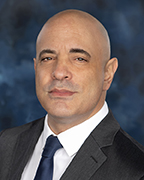
In 2017, Ozarks Technical Community College (OTC) in Springfield, Missouri, launched a redesigned website that turned heads with its simplicity. At a time when many college and university websites were becoming more cluttered and confusing to navigate, OTC went the other way: a basic site with an image and a prominently featured search button — the idea being a simple word search is faster and less cumbersome for visitors than searching through various tabs.
Today, the college is preparing to again redesign its website. As in 2017, George Lamelza, OTC’s college director of web services, will lead the year-long project. Below, he discusses the reasons for OTC’s revamp and answers some general questions about college website redesigns.
* * *
What were some of the factors that prompted discussions about a redesign of the OTC website?
The college has been focused on simplifying the student experience at every touchpoint. As part of the college’s new strategic plan, Dream. Plan. Build., the website redesign will continue this focus. Our charge is to redesign the OTC website to provide a streamlined and intuitive experience to prospective and current students.
Where do you begin on such a huge project?
We start by identifying stakeholders and finding out what features are most important to them. Serving students is always our top priority, but we also must be aware of how changes affect faculty, staff and other visitors. This year, we’re listening to people from across the college community as they tell us what they need from the website. We will do this alongside our campus partners in strategic planning.
Next, we look at the data. We have been collecting data on the website since 2012. Additionally, we are planning an external audit, including an ethnographic study of user behavior, to get an objective view of what can be improved. We will compare this information with the user feedback we receive to pinpoint commonalities and see whether what people are saying matches what they’re doing. Once we know what we need to do, we begin making changes while continuing to gather feedback on the newer iterations.
Are you approaching it differently than the strategy you used for the previous design, or is it largely similar?
The general process will be similar, but our web design strategy will be different. In the past, the approach was broad and standardized. Today, our focus is on personalizing the experience to ensure each user has their individual needs met. The previous redesign was also a major undertaking, moving from one CMS to another. That won’t be taking place this time, but we will be completely redesigning all the elements, page types and general flow of the site.
How are students and visitors to the website using the site differently now than five years ago?
Our traditional-age students are digital natives who have grown up being served personalized experiences by companies like Netflix and Spotify, who excel at content curation. They expect tailored web services, and they expect to be able to access them on mobile devices. At OTC, the culture has shifted from “you come to us,” to “we come to you.” You see this in our student success model, which has received national praise for changing the way a student receives help and care throughout their college career. Our website needs to reflect that model and the expectation that we’re meeting each student where they’re at.
What are some common mistakes colleges make when they redesign their websites?
Overcomplication. As I have said since the very beginning, simple is better. Too many colleges expand their web systems without planning for how changes will affect sustainability. What begins as an exciting project can devolve into a mess if information, terminology and brand standards are inconsistent. We must keep it simple but personalized. How we do that digitally is the exciting part of embarking on this journey as a college.
Mind if we check in with you in a few months to see how things are progressing and maybe share your experiences?
That would be great! We would like you to follow us on this journey. We’re excited about this project and the many ways it will benefit our students and our community. We can all discover the best ways to do that together.

